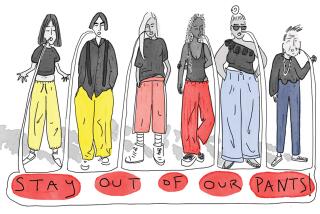Beauty and the Beach : Swimsuit Industry Zeroes In on Figure Flattery
- Share via
For almost every woman, the thought of buying a new swimsuit is filled with dread--and longing. If only she weren’t so fat. If only she had a tan. If only the store’s fluorescent lights weren’t so cruel. If only she could find a salesperson. If only someone made a magic suit, one that would trim her waist, flatten her tummy, perfect her bosom, lift that derriere and whittle those thighs.
“A swimsuit is the most painful apparel purchase a woman can make,” says Eleanor Walsh, marketing and communications specialist for Du Pont, makers of the Lycra used in swimwear.
But help is on the way.
This year, there is a flood of fashionable, forgiving styles that tuck, trim and camouflage without looking dreary as dishwater. In theory, these kinder, gentler suits are aimed at a maturing baby boomer who cannot or will not wear the teeny-weeny bikinis and itty-bitty maillots of her youth. But in reality, they are for any female who has figure flaws--or thinks she does. And that includes just about everyone.
“Every woman feels self-conscious in a swimsuit,” claims Catherine Hansen, in charge of merchandising and design at Jantzen. “If you asked super-models Christie Brinkley or Paulina Porizkova if they are happy with their weight, I’m sure they would say, ‘Oh, I could lose 5 pounds.’ ”
That imagined response triggered the name of Jantzen’s pioneering “5 Lbs. Under” collection, introduced five years ago. Like the concepts that have followed from other companies, Jantzen’s “figure concern” suits use internal construction and exterior designs to smooth, lift, tighten, reproportion and trim the body.
Figure-enhancing suits are so prevalent this season that Anne Eberhardt, buyer for misses swimwear at the Broadway, estimates 38% of her stock has tummy control panels, compared with 18% to 20% last year. And sales of two-piece suits are up 14% this year, thanks to high-waisted bikinis, “which mean more women can wear them and feel comfortable. They don’t feel as if their stomachs are falling out.”
Stomach control is the feature most customer’s crave. Jantzen suits, as well as others, feature what is called a power-net front lining that works like the control top on panty hose.
“It doesn’t actually take off inches, but it makes you feel much more comfortable. It holds you in,” Hansen explains.
Additionally this season, there are underwire bras, lower-cut legs, soft padded bras and what Hansen describes as “soft, skirted styles that provide excellent camouflage to the tummy, hip and thighs. It’s a modern, sexy, glamorous way to cover up.”
Other labels in on the trend to one degree or another carry the names of celebrities such as Esther Williams and Jerry Hall, fashion designers like Bill Blass and Oscar de la Renta, swimwear old-timers like Anne Cole, Rose Marie Reid, Robby Len and Roxanne, along with relative newcomers like Cherokee, Body I.D. and Slimsuit.
Carol Wior’s Slimsuits, introduced three years ago, come with a tape measure to prove the “measurable difference.” Wior says her biggest market is women 25 to 35, most of whom have had babies. But from store surveys she conducts, she knows she has customers as young as 14, as old as 78, all eager to enhance their appearance.
Tudor Martin, vice president of merchandising for Sirena, explains that his company entered the body-contouring swimwear market last year with its Streamlines label, after research showed most women believe they have at least two figure flaws.
“In order to qualify for Streamlines, every suit must address at least two of the consumer-perceived problems: bustline, waist, stomach, hips and thighs,” Martin says.
At Body I.D., Jim Post says research proved to him and partner Pattie Byrnes that “9 out of 10 women don’t know what looks good on their body types.”
The company, a year-old division of Montreal-based Maillot Baltex, offers suits for six body types: long torso, short torso, full bust, small bust, full hips and ample tummy. Oversized hangtags show a before photo and eight suits that can help solve the particular figure problem.
Typical of its offbeat marketing approach, Body I.D. doesn’t use professional models.
“That’s the worst psychology in the world,” Post says. “A woman looks at a model with a drop-dead body and says: ‘Sure, she can wear that, but what is it going to look like on me?’ We use neighbors and friends who are very brave.”
A personal touch of a different sort goes into the Esther Williams label, introduced late last year and manufactured by Excelsior Inc., which also produces private label suits, Pierre Cardin beachwear, Bare Assets and H2O.
The actress, who played a swimwear designer in the 1949 movie “Neptune’s Daughter,” thinks she’s “either caught or caused a trend back to the classics.”
She claims to have had a major influence on the 106-piece glamour-oriented line, getting inspiration from her scrapbook, calling on well-endowed celebrities (such as former Miss U.S.A. Courtney Gibbs) to model and insisting on the right fit. “I’m a proponent of length in a swimsuit, so you don’t have to decide whether to cover your bosom or your bottom.”
A spokesperson for Jerry Hall says the famous cover girl goes shopping in Monte Carlo for the fabrics used in her $50-$110 suits made in London.
Last week, Hall was promoting the line at Marshall Field’s in Chicago. While not designing for “a particularly heavy woman,” Hall is said to keep in mind that “not all women have a flat stomach or a small rear. Her suits are bust enhancing and have full bottom coverage for a great exit.”
At Cherokee, food and swimwear are compatible, according to hangtags that tell customers to “have a little something to eat and don’t worry. We will help you look fabulous.”
Doug Arbetman, president of the company’s new swimwear division, says the playful tags were devised to indicate “what the power netting can do.” Yet, he admits, “We’re not talking a miracle, we’re talking help.”
He uses double-seam stitching under the bust and along the sides of the suit instead of inserting soft cups or shelf bras. They would age his very young-looking suits, he says. But he has gone along with an industry trend for more leg coverage, explaining that arched curves on skater-style skirts or on the leg holes themselves are flattering camouflage.
Doesn’t this new coverage seem strange when women are supposedly working out more than ever?
“Many women might be exercising,” the Broadway’s Eberhardt answers, “but only a small portion of them are exercising to the extent of Jane Fonda. And no matter how much they’re doing, most women are not fully comfortable with their bodies when they’re out there baring all to the world.”
Without doing a simple experiment in the dressing room, a woman may discover she has bought less coverage than she thinks.
“The one thing everyone forgets to do is bend over and touch their toes,” Eberhardt cautions. “If the suit rides up too much, go to the next size.”






